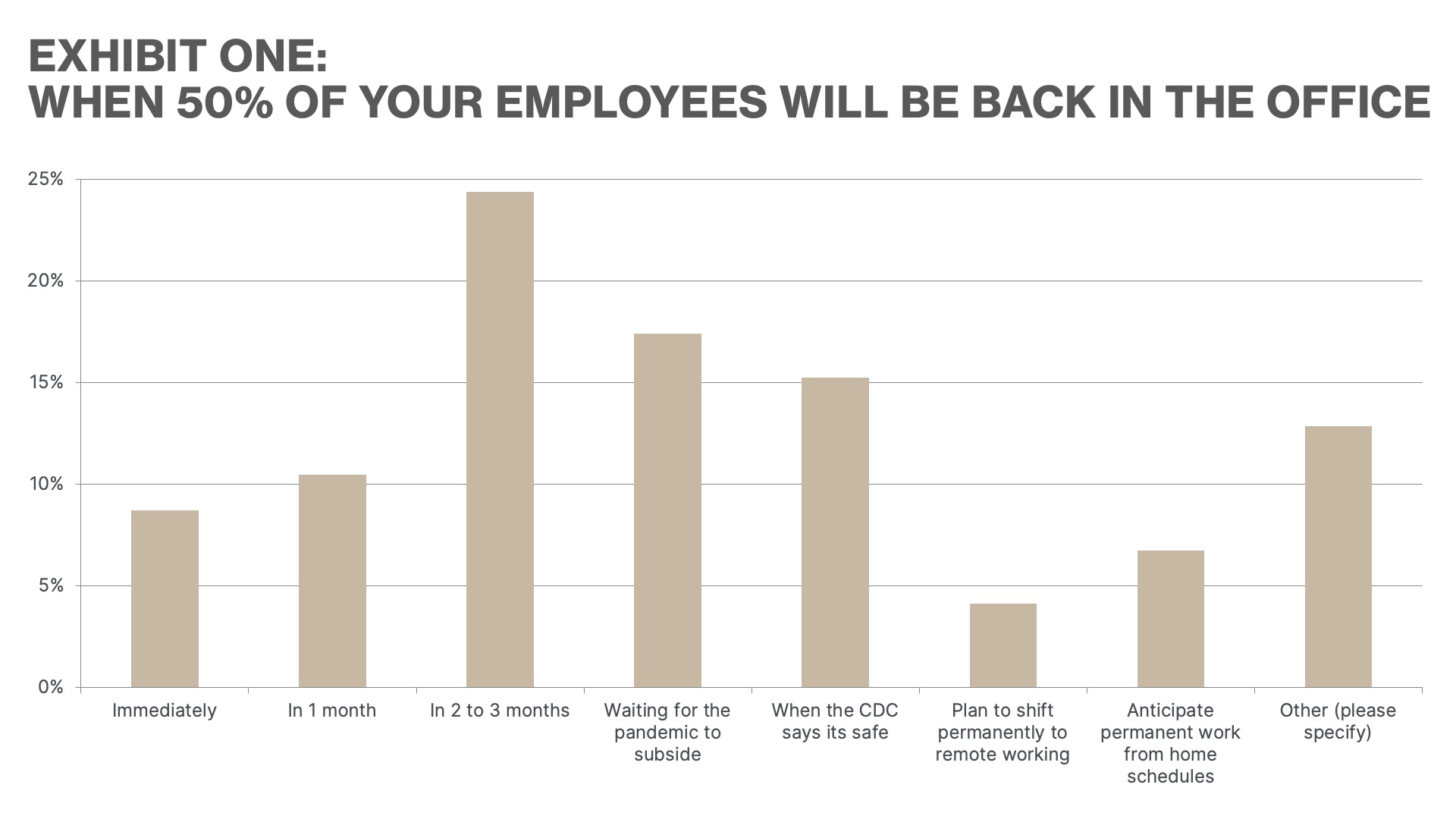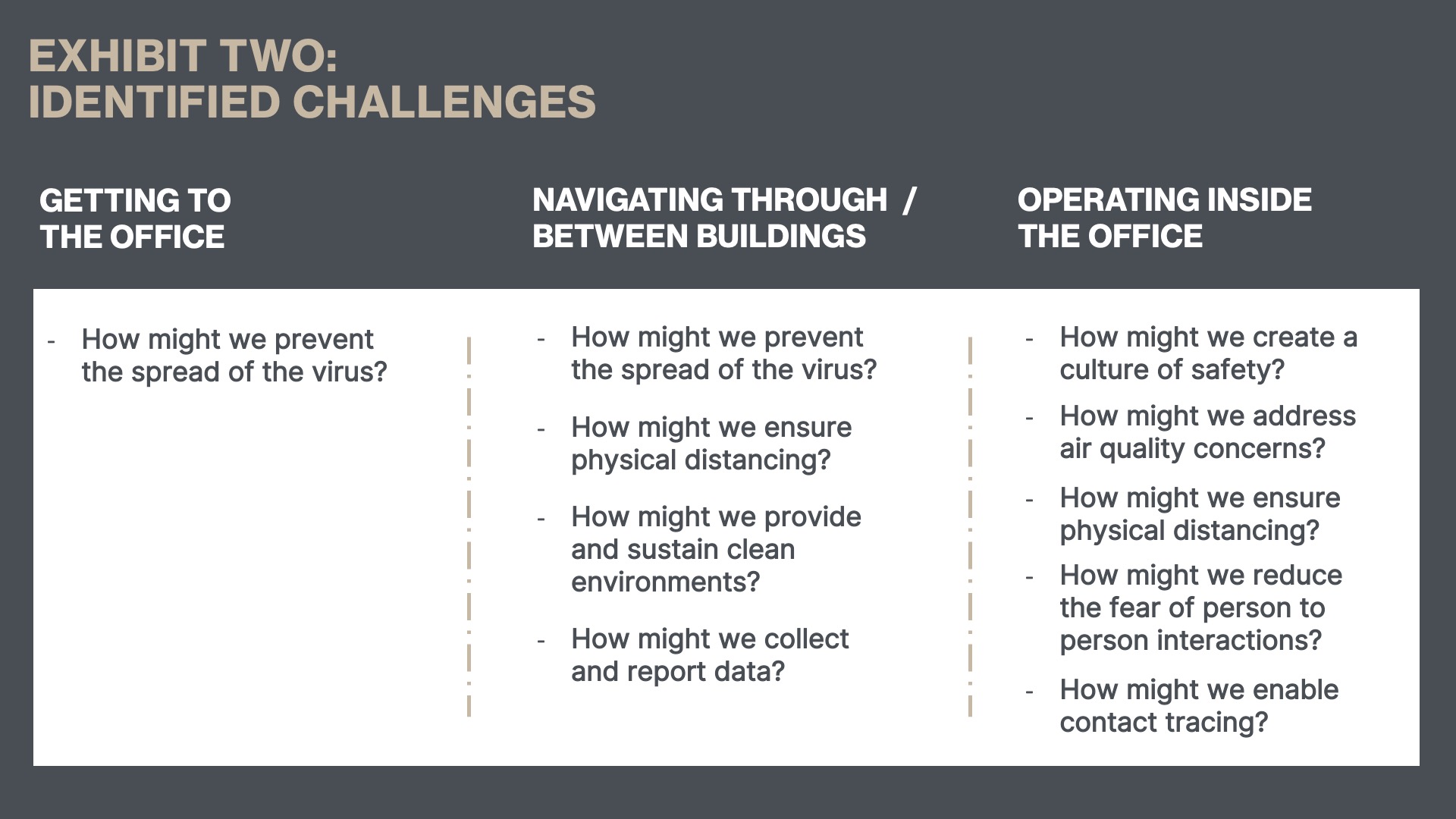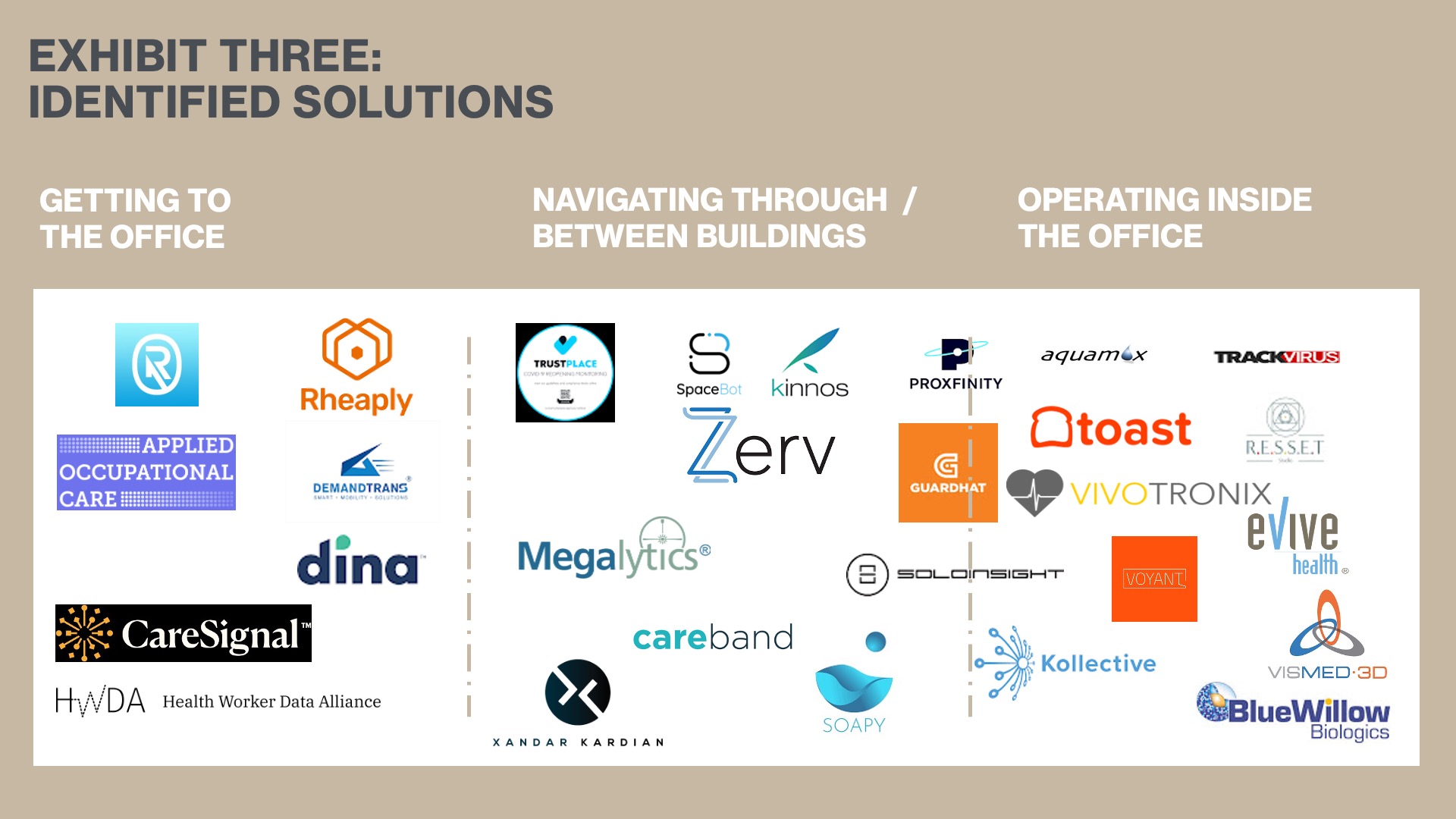Returning to the workplace safely: Lessons from cross-industry leaders
This article originally appeared on cprcovid-19.com.
Authors: Betsy Ziegler, Steven Collens and Haven Allen
As Chicago entered Phase 3 on June 3rd, many businesses started to resume on-site operations, joining those considered essential who have operated at partial- to-full-capacity over the course of the pandemic. Work environments vary widely — both internally (e.g., plant operations and office operations) and externally in terms of what is in a leader’s control (e.g., the proximity of interaction and level of exposure) — and have different expectations on timing of when the majority of employees will return to the office.
Recognizing there is no magical answer, the teams of mHUB, MATTER and 1871 convened 50 executives representing 40 organizations, ranging from healthcare to manufacturing to office-based employers, to discuss their needs (original survey results) and challenges, as well as decisions they’ve made and solutions they’ve identified to keep their employees healthy and safe physically and psychologically as they return to the office. Our three organizations bring a unique lens to these issues: collectively we represent more than 1,000 entrepreneurial ventures and have a deep understanding of how solutions are developed in response to industry needs.
While the businesses we talked with varied widely, the journeys of their employees on an average workday typically follows three, similar stages:
- Getting from home to the workplace
- Moving within and between buildings; and
- Operating inside the office
In addition, it is clear that the process of returning back to the office will be a long one. A majority of the businesses we talked with do not expect more than half their workforce to be back in their offices for at minimum 2-3 months. (See EXHIBIT ONE)

This article describes several decisions made, new practices adopted, and innovative solutions identified throughout the employee journey that are applicable across sectors and worth considering as you and your teams create and execute your plans. (See EXHIBIT TWO)

Getting from home to the workplace
The vast majority of Chicagoland workers use public transportation to get to their workplace. Given the safety of public transport is not in the employer’s control, organizations dependent on it for their employees have made a wide range of decisions ranging from banning it altogether and reimbursing for parking or ride-sharing, to creating office mud-rooms at their entrances to store bags and jackets, to changing work schedules to avoid rush hour, to encouraging and, at times, supplying personal protective equipment (PPE). For those searching for PPE for their employees, please see the Chicago PPE Market created by Rheaply, in partnership with the City of Chicago.
Molly Poppe, chief innovation officer of the Chicago Transit Authority, who participated in our discussions, shared results from studies in Paris and Tokyo stating that some reduced capacity in train cars and buses coupled with wearing face coverings are the most important levers to reducing exposure on public transit.
“The CTA has implemented multiple strategies to provide the highest level of service and the cleanest, most comfortable environment possible for our customers when they return to public transit. This includes requiring face coverings at all times while using CTA, launching a Ridership Information Dashboard that provides information on bus crowding and routes and times with more space, establishing passenger capacity limits for buses and trains, distributing hand sanitizer and masks to our customers, sending a ‘Returning to the CTA Guide’ to update our riders on what to expect when they return to CTA, and running our normal schedule to provide for maximum social distancing,” said Poppe. “We are also enhancing our cleaning procedures with additional cleaning personnel and by testing new products and technologies.”
Many organizations are also making pre-screening tools like Applied Occupational Care and Dina mandatory, where each employee has to share a “green screen” or a similar confirmation cue that they are safe to enter. These tools don’t fully solve for asymptomatic team members, but they are important in setting norms for the workplace and emphasizing personal responsibility.
Moving within and between buildings
Many employees work in large office towers and others on campuses where movement between buildings is common. These circumstances are often outside the immediate control of the employer and determined by the landlord. Three major themes emerged in the discussion:
Preventing the spread of the virus:
In any building you walk into, you see signs for mandatory face coverings, labels on the floor instructing you on which direction to walk, limited capacity on elevators, and in some cases additional hand washing stations installed.
“Building owners and employers are working in tandem to ensure workers feel safe as they return to office buildings. From the moment of entry, buildings are using new wayfinding and signage to offer information about the health of the building and guide visitors to maintain distance as they wait for elevators and enter them at reduced capacity”, said Todd Heiser, Managing Director and Principal at Gensler. “Once in the office, employers are de-densifying conference spaces, enacting new protocols on sanitization and restroom usage, and creating space between workstations to offer a clean, distanced environment for employees.”
Providing and sustaining clean environments:
Getting this right is hard and is on the minds of every landlord and employer. Almost all have increased the frequency of their cleaning and have added new guidelines and expectations of employees and visitors to wipe down surfaces when they are done using a space.
New solutions are needed in this area that are not just about adding more labor. A new company, Aquamox is using diamond technologies to develop devices that generate ozonated water, which can be used as a sanitizer to prevent the spread of pathogens such as viruses and bacteria. The product will be able to generate ozonated water from tap water and electricity, without the need for any other consumable.
Collecting and reporting data:
Many large office buildings and employers are navigating how to track, receive and report information about a positive COVID case in their space. In all cases, this is dependent on the person impacted reporting and then the organization determining how to communicate out those results, i.e., do you share with everyone who may have been in the building at the same time?, do you share only with those that are in proximate distance for a set period of time? Based on the conversations we’ve had, we believe there will be a lot of testing and learning when it comes to communications. We expect to hear updates frequently over the next 12+ months and employers and landlords will need to find approaches where people continue to pay attention and take necessary actions needed to stay safe.
Operating inside the office
As expected, the primary focus of our problem-solving series centered on what happens inside the office environment as the majority of these choices are often more within the control of the employer. Five major themes emerged in the discussion:
Creating a culture of safety:
One of the key focuses for employers is how to consciously create and foster a culture of safety in the workplace, i.e., detailed processes and training are needed to help ensure the safety of employees at every stage of accessing a building, from temperature checks at entry to isolating personal computer accessories in a designated location when not in use.
“Employee wellness and safety have been at the center of our decision making process since the onset of the COVID-19 pandemic,” said Sasha Diskin, Executive Director, Talent Management, Horizon. “We immediately updated our sick leave policy to ensure that employees could care for themselves or their loved ones. We also put in place regular touchpoints with employees, from weekly manager webinars focused on creating a healthy virtual work experience to bi-weekly virtual all-employee meetings where employees were encouraged to ask any question to CEO Tim Walbert. Above all, we have communicated that no employee will be required to return to an office or the field unless their comfort level allows. Our ability to act swiftly to adapt to changes in guidelines has helped reassure employees and instill confidence that we will always do what’s right for them and the health care providers and patients we serve.”
Addressing air quality concerns:
By far, the number one concern on our initial executive survey was regarding airflow and HVAC, with many of our participants working in larger office buildings and not being able to fully control these decisions and outcomes.
Raj Gupta, executive chairman of Environmental Systems Design, Inc. (ESD), has been leading the organization’s efforts to improve indoor air quality and wellness in buildings. Raj shares “Enhanced air cleaning devices like UV lights or bipolar ionization technology are helpful, but the biggest impact comes from social distancing, individual hygiene and regular cleaning.” In addition to these strategies, ESD leverages the capabilities of existing HVAC systems to improve indoor air quality. The measures include the following steps: bringing in more outside air to dilute the concentration of contaminants; increasing the amount of exhaust air from bathrooms; upgrading to MERV-13 air filters; and using smart sensor technology to measure the amount of CO2 in the air.
Reducing the fear of in-person interactions and ensuring physical distancing:
Given the uncertainty about this virus, efforts of employers are as much about ensuring psychological safety as they are about physical safety. And while all organizations we spoke with have put up signage, taken out physical tables and chairs, shut off rooms, etc., to ensure appropriate physical distancing, many executives shared their efforts to dramatically increase communication with a focus on transparency and asking for ongoing input and feedback.
Enabling contact tracing:
One of the trickiest challenges due to both the technology itself and privacy considerations is contact tracing. Companies like Proxfinity, Megalytics, and SpaceBot are all engaged in helping their clients deliver data, and insights to enable informed decision making.
“Computer vision is playing an important role in monitoring PPE compliance and social distancing. Bluetooth based contact tracing, like that offered by JCI, is better suited to address the privacy and accuracy challenges demanded by contact tracing. There are a variety of offerings designed to meet companies’ COVID-19 related needs,” said Robert Lock, senior vice president of corporate development at Johnson Controls. “It’s important, however, to select a trusted partner to work with in order to make sure these solutions work well together as companies start to bring employees and customers back to the office, plant, or store.”
We have highlighted companies across our innovation network delivering solutions for these challenges. Please see EXHIBIT THREE for a summary of solutions shared across the employee framework.

This is a complex, uncertain time with no easy answers. As Chicagoland continues to re-open and every day brings new learnings and insights, we encourage you to consider joining these conversations and partnering with us as you continue on your journey. You can access this information and more at CPRCOVID19.com. Our organizations support more than 1000 early-stage companies and we are in the unique position of seeing the latest technology as it comes online. We can connect you and your teams easily to novel solutions and, in situations where you have challenges that do not have clear solutions, we can support you in guiding and developing new technology.
For more information:
mHUB
mHUB is the nation’s largest and fastest growing innovation center for physical product development and manufacturing. mHUB is a community of product designers and developers, entrepreneurs, engineers and manufacturers, a network of manufacturing mentors, industry experts and investors and a source of intellectual and economic capital. Launched in 2017, mHUB’s community has grown 30 to more than 270 member companies that have generated more than $100M in revenue, launched more than 930 products, hired more than 1,300 employees, and raised nearly $148M in lifetime capital. Learn more at mHUBChicago.com
MATTER
MATTER, the premier healthcare incubator and innovation hub, includes hundreds of cutting-edge startups from around the world, working together with dozens of hospitals and health systems, universities and industry-leading companies to build the future of healthcare. Together, the MATTER community is accelerating innovation, advancing care and improving lives. For more information, visit matter.health and follow @MATTERhealth.
1871
1871 is Chicago’s digital technology hub and the #1 ranked private business incubator in the world. It exists to inspire, equip, and support founders building extraordinary businesses. Located in the historic Merchandise Mart, 1871 is home to ~400 technology startups and ~1,500 members supported by an entire ecosystem focused on accelerating their growth and creating jobs in the Chicagoland area. The nonprofit organization has 350 mentors available to its founders, alongside access to more than 100 partner corporations, universities, education programs, accelerators, venture funds and others. Since its inception in 2012, more than 650 alumni companies are currently still active, have created over 11,000 jobs, and have raised more than $1.65 billion in follow-on capital.



-beed37.png?ixlib=jekyll-1.1.0&w=140)